Edit Construction



Edit Construction |
  
|
Editing lines
The "EC: Edit Construction" command is provided for editing construction lines. It is one of most often used commands. This is the command that supports creation of new drawing configurations by providing a dialog box for varying necessary construction parameters. The command allows editing all kinds of construction entities.
The command is called as:
Icon |
Ribbon |
|---|---|
|
Draw → Additional → 2D Construction |
Keyboard |
Textual Menu |
<EC> |
Edit > 2D Construction |
To modify location of some construction entity, simply select it using ![]() , move the cursor over the desired location, and click
, move the cursor over the desired location, and click ![]() again. To specify the exact value of the placement parameter, use the property window or the parameters dialog box via the
again. To specify the exact value of the placement parameter, use the property window or the parameters dialog box via the ![]() option. If the entity was driven by a variable, the system will output a warning.
option. If the entity was driven by a variable, the system will output a warning.
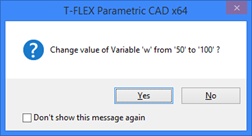
To avoid the system warnings, call the option ![]() before selecting any entities. A dialog box will come up, in which the item "Auto change Variables" needs to be checked.
before selecting any entities. A dialog box will come up, in which the item "Auto change Variables" needs to be checked.

When modifying the values of construction parameters it is possible to use Relations that appear on element selection. These Relations are temporary. They will automatically disappear on editing finish. To modify the values of construction parameters with the help of Relations it is necessary to turn off “Dynamic recalculation” mode (option ![]() , see below).
, see below).
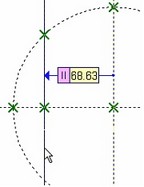
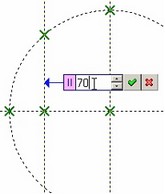
It is possible that some construction entity can't be recreated after modifying parameter values due to geometrical incompatibilities among the entities. In such a case, the system will output an error message and specify the particular failing relation.
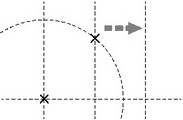
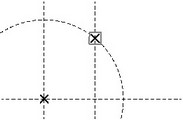
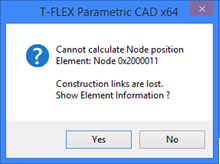
The selected line is highlighted on the drawing. Besides, other construction entities are highlighted that were used as references for the line creation. The following options are available in the command "EC: Edit Construction":
|
<> |
Dynamic model regeneration mode |
|
<P> |
Set command options |
|
<O> |
Create Name for selected Element |
|
<M> |
Modify Construction Line relations |
|
<T> |
Update selected Line(s) extents |
|
<Q> |
Update all Line extents |
|
<K> |
Break link with variable |
|
<I> |
Select Other Element |
|
<R> |
Select element from list |
|
<*> |
Select All Elements |
|
<Del> |
Delete selected Element(s) |
|
<Esc> |
Cancel selection |
<Shift><Enter> |
Add Construction Element to Selected for Editing |
|
<Ctrl><Enter> |
Exclude Construction Element from Selected List |
|
The option ![]() (<K>) allows switching all parameters of the selected construction line from dependency on variables to the constant values.
(<K>) allows switching all parameters of the selected construction line from dependency on variables to the constant values.
The option <O> allows specifying names for construction lines in order to define advanced parametric dependencies. Such a name will help exactly identify a construction line and, in particular, directly access certain proprietary data of the line in the variable editor via the command "V: Edit Variables", using the function "get". The name is not required for common situations of parametric design.
Modifying relations between construction lines
If for some reason you would like to modify the existing relations between the construction lines, this can be easily done using the ![]() option. Let's review an example of using this option. The line 1 is created at a given angle to a vertical line. Besides, it is passing through a node at the intersection of the vertical and a horizontal line. The circle 2 was constructed tangent to the lines 1 and 4, while the line 3 tangent to the circle 2.
option. Let's review an example of using this option. The line 1 is created at a given angle to a vertical line. Besides, it is passing through a node at the intersection of the vertical and a horizontal line. The circle 2 was constructed tangent to the lines 1 and 4, while the line 3 tangent to the circle 2.
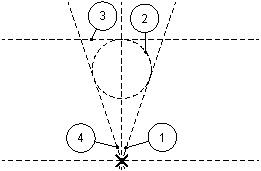
Suppose, you would like to make the line 1 parallel to the vertical line. Since other construction entities are created using the former line as a reference, the line may not be simply deleted and then differently created anew. The deletion of this line would require also removing the line 3, followed by removal of the circle 2. This is exactly the case when the option <M> is to be used. Enter the command "EC: Edit Construction" and select the line 1 for editing. This line will get highlighted along with another line and the node used as references for this line creation.
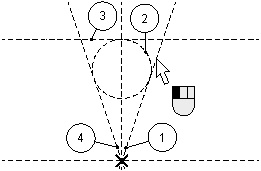
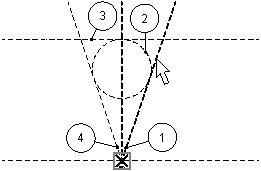
After selecting the line, type <M> for modifying the definition of the line 1 construction. Note that the system brought you into the construction line creation command, "L: Construct Line". Now you can create this line as if anew. The difference from constructing a line without using the <M> option is that both the line being modified and the reference line are both highlighted on the screen. Select a line - the reference for the line 1 to be parallel to. Then rubberband the new line to the desired distance from the reference and fix that location by clicking ![]() .
.

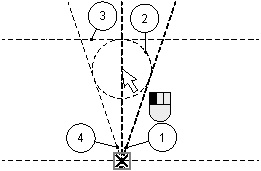
Line 1 will appear in the new position, while all the rest of entities using the line as a reference will keep their relations with the line, as, for instance, the circle 2 will remain tangent to the line 1. The only restriction on modifying relations between construction lines is a ban on recursive definition, that is, the line may not reference itself. Should this occur, a message will be displayed about recursion, and the modification will be cancelled. With this exception, any relations between lines and circles may be modified at any time. This functionality is especially useful on importing drawings from other systems, such as, for example, *.DXF or *.DWG files of the AutoCAD system.
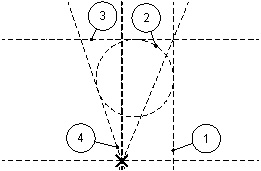
Deleting construction lines
To delete a construction line, simply select the line using ![]() and call the <Del> option. If the line is not referenced by any other drawing elements, it will be deleted. Should there be other elements defined based on the selected line, a warning will appear about deletion of all elements related with the line.
and call the <Del> option. If the line is not referenced by any other drawing elements, it will be deleted. Should there be other elements defined based on the selected line, a warning will appear about deletion of all elements related with the line.
Editing circles
Besides, when editing a circle tangent to two lines, the automenu gains additional options for setting and clearing a "link" with a node:
|
<G> |
Apply snapping to a node |
|
<B> |
Cancel snapping to a node |
The option ![]() is used for constraining a circle, tangent to two lines, by an additional node defining the tangency configuration. Upon calling the option, select the desired node by clicking
is used for constraining a circle, tangent to two lines, by an additional node defining the tangency configuration. Upon calling the option, select the desired node by clicking ![]() . The circle will be reconstructed as the result of using this option to pass as close to the node as possible. This allows to uniquely define the circle location with respect to the reference lines.
. The circle will be reconstructed as the result of using this option to pass as close to the node as possible. This allows to uniquely define the circle location with respect to the reference lines.
The example below explains the use of this capability. The location of the lines on the drawing is defined with respect to the symmetry axis using a parameter K. Both circles are constructed tangent to the two lines. Besides, the solid-drawn circle is "linked" to the highlighted node. Meanwhile, no reference node is defined for the second circle. Originally, with the variable K=1, the drawing looks like shown on the diagram on the left-hand side. The right-hand side diagram shows the drawing modification per the new variable value К=-1. The circle linked to the node adjusted correctly. The second circle that did not reference any node, flipped with respect to the symmetry axis.

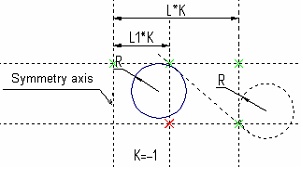
To release or re-assign a link with a node, use the option ![]() .
.
Editing splines
Editing splines includes changing spline shape, adding or deleting defining nodes and modifying various parameters. Spline editing is done in the command "EC: Edit Construction". Once a particular spline is selected for editing (by pointing to with the cursor and clicking ![]() ), then the spline curve will be highlighted together with the defining nodes.
), then the spline curve will be highlighted together with the defining nodes.

The following options become available in the automenu:
![]() <Enter> Select the nearest defining node of the spline to modify
<Enter> Select the nearest defining node of the spline to modify
![]() <P> Set costruction line parameters
<P> Set costruction line parameters
![]() <V> Mode of dynamic recalculation of model
<V> Mode of dynamic recalculation of model
![]() <Y> Create Name for selected Element
<Y> Create Name for selected Element
![]() <I> Selected Other Element
<I> Selected Other Element
![]() <Del> Delete selected Element(s)
<Del> Delete selected Element(s)
![]() <Esc> Cancel selection
<Esc> Cancel selection
Once a defining node of the spline is selected by clicking ![]() , it can be reassigned by selecting another node, delete, or add a new one. Once a defining node is selected, the spline begins rubberbanding, following the cursor, just like at creation time. A following mouse click
, it can be reassigned by selecting another node, delete, or add a new one. Once a defining node is selected, the spline begins rubberbanding, following the cursor, just like at creation time. A following mouse click ![]() selects another node or creates a new one. For convenience, the old node gets deleted if it was not referenced by any other element.
selects another node or creates a new one. For convenience, the old node gets deleted if it was not referenced by any other element.
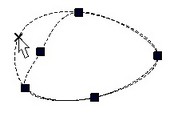
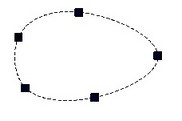
Note that the node position and, therefore, the shape of the curve, can be modified in the node editing command "EN: Edit Node".
To add a new defining node use the option <I>.
![]() <I> Switch to "Insert Point" mode
<I> Switch to "Insert Point" mode
Note that the insertion of the new node will be before or after the selected node, depending on where the cursor was at the instant of option activation.
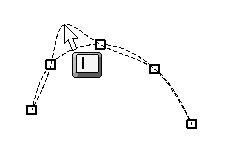
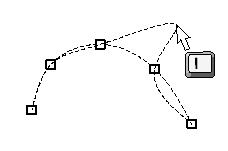
To fix the new node, click ![]() .
.
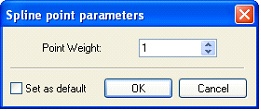
Editing 2D paths
By editing a path, one can add or delete nodes, select a different construction line to connect the end nodes of a particular path segment, as well as define new parameters.
Editing is done in the command "EC: Edit Construction".
Icon |
Ribbon |
|---|---|
|
Draw → Additional → 2D Construction |
Keyboard |
Textual Menu |
<EC> |
Edit > 2D Construction |
A path can be selected by pointing the cursor and clicking ![]() , or by the option:
, or by the option:
![]() <S> Select Spline
<S> Select Spline
As a result, the selected path gets highlighted, and its nodes marked.
Editing the type of a particular path segment
To modify the type of a particular path segment, do the following steps:
● Select a path;
● Using the mouse, select the path segment whose type needs to be modified;
● Select a construction entity defining the new type of the path segment: line, circle, ellipse and spline (including other 2D paths). Selection of a construction entity is done using the appropriate option. The end nodes of the path segment being edited must belong to the selected construction entities;
● Exit the particular path segment editing mode by right-clicking ![]() or pressing <Esc> on the keyboard.
or pressing <Esc> on the keyboard.
● Confirm changes by the option:
![]() <Ctrl+Enter> Finish input
<Ctrl+Enter> Finish input
Let's review an example explaining the process of editing a particular segment of a path contour. The diagram shows the original path. The wave segment is to be replaced by a straight line. Call the command "EC: Edit Construction" and select the path. The next diagram shows the situation after selecting the path.
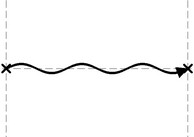
The contour is highlighted, and the end nodes are marked by small boxes. Move the cursor over the contour segment to be edited (the wave line in this case) and click ![]() . The selected contour segment will be highlighted and its nodes marked with larger boxes. This state is shown on the next diagram.
. The selected contour segment will be highlighted and its nodes marked with larger boxes. This state is shown on the next diagram.
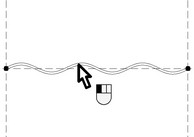
Select the straight line passing through the edited contour nodes by moving the cursor over and typing <L> key. The edited path segment now assumes the desired shape. The system still remains in the selected path segment editing mode. If transforming this segment is over, quit the current segment editing mode by right clicking ![]() or pressing <Esc> on the keyboard.
or pressing <Esc> on the keyboard.
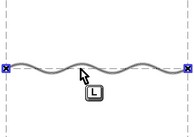
The icon ![]() becomes then accessible in the automenu. If there are no more modifications to the path, push
becomes then accessible in the automenu. If there are no more modifications to the path, push ![]() or <End> key. What is left is just changing the graphic line type, if necessary.
or <End> key. What is left is just changing the graphic line type, if necessary.
Similarly, one can replace a path segment with a circular or elliptic arc, or a spline segment, or a part of another path, if the circle, ellipse, spline or path is constructed based on the marked nodes. Simply use the appropriate option among <C>, <E> and <S>. If the new path segment was not created based on the marked nodes yet passes through them, then editing such path segment can be done using the option "Switch to 'Insert Point' mode" (the icon ![]() or the <I> key). This option will be fully described below.
or the <I> key). This option will be fully described below.
The selected segment of the path between two nodes can be replaced as many times as necessary. The path segment will stay selected until the user quits by right clicking ![]() or pressing <Esc>. If a contour segment was modified using the option "Switch to 'Insert Point' mode" (the icon
or pressing <Esc>. If a contour segment was modified using the option "Switch to 'Insert Point' mode" (the icon ![]() or <I> key), then the selected contour segment gets unselected after the change (no need to press <Esc>). Meanwhile, the system will remain in the path contour editing mode until the confirmation by
or <I> key), then the selected contour segment gets unselected after the change (no need to press <Esc>). Meanwhile, the system will remain in the path contour editing mode until the confirmation by ![]() or <End> key.
or <End> key.
Deleting a node inside path contour
To delete a node inside a path contour, do the following steps: Select a path (point at by the graphic cursor and click ![]() ); Select the path segment the node belongs to (point at by the graphic cursor and click
); Select the path segment the node belongs to (point at by the graphic cursor and click ![]() ); Select the node to delete (point at by the graphic cursor and click
); Select the node to delete (point at by the graphic cursor and click ![]() ); Delete the selected node (the icon
); Delete the selected node (the icon ![]() or the <Del> key); Confirm changes (the icon
or the <Del> key); Confirm changes (the icon ![]() or the <End> key). As a result, the new path segment passes through the two neighboring nodes.
or the <End> key). As a result, the new path segment passes through the two neighboring nodes.
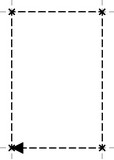
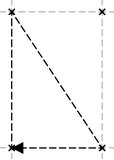
Modifying a node position within path contour
To modify position of a node within a path, do the following steps: Select a path (point at by the graphic cursor and click ![]() ); Select the path segment the node belongs to (point at by the graphic cursor and click
); Select the path segment the node belongs to (point at by the graphic cursor and click ![]() ); Select the node to move (point at by the graphic cursor and click
); Select the node to move (point at by the graphic cursor and click ![]() ); Move the node to the desired position (the segments connecting the node to neighbors will rubberband as the node is moved); Fix the node (point the cursor at an intersection of construction lines and click
); Move the node to the desired position (the segments connecting the node to neighbors will rubberband as the node is moved); Fix the node (point the cursor at an intersection of construction lines and click ![]() , or type <N> in the case of using an existing node). Confirm changes (the icon
, or type <N> in the case of using an existing node). Confirm changes (the icon ![]() or the <End> key). As a result of moving, the node will be connected with the neighbors by straight line segments, regardless of the former types of connecting entities).
or the <End> key). As a result of moving, the node will be connected with the neighbors by straight line segments, regardless of the former types of connecting entities).

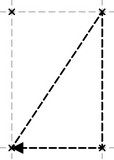
Creation of additional nodes on a path contour
To create additional nodes on a path contour, do the following steps:
● Select a path (point at by the graphic cursor and click ![]() );
);
● Select the contour segment to split by new node(s) (point at by the graphic cursor and click ![]() );
);
● Turn on the point insertion mode (the icon ![]() or the <I> key), and click on a contour segment. The segment becomes split in two, with the new node between them. The node and the segments rubberband with the cursor, the solid line segment connecting to the previous node and the dashed line to the next one. The order of the nodes after the insertion will be determined by the system automatically, depending on the path contour direction. Do not click on a segment near a vertex, as, instead of adding a node, this will start moving the existing node;
or the <I> key), and click on a contour segment. The segment becomes split in two, with the new node between them. The node and the segments rubberband with the cursor, the solid line segment connecting to the previous node and the dashed line to the next one. The order of the nodes after the insertion will be determined by the system automatically, depending on the path contour direction. Do not click on a segment near a vertex, as, instead of adding a node, this will start moving the existing node;
● Close the contour between the newly created node and the successive one. A shortcoming of the functionality is unavailability of the option "select graphic line";
● Contour input is complete once the closing node is selected, or the icon ![]() or the <End> key is pressed.
or the <End> key is pressed.
The system returns to the mode "Contour selected for editing". One can do other modifications, and then confirm all changes.
● Confirm changes (the icon ![]() or the <End> key).
or the <End> key).
Let us illustrate the above with a specific example. Suppose, a path contour is to be modified as shown on the diagrams. To get the result, begin with calling the command "EC: Edit Construction". Then, using the option "Select Spline" (the icon ![]() , or the <S> key), select the path contour to be modified. Now, to get the result, perform the steps shown on the following diagrams.
, or the <S> key), select the path contour to be modified. Now, to get the result, perform the steps shown on the following diagrams.

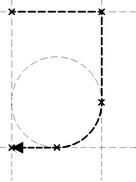
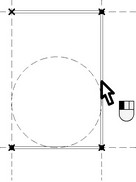
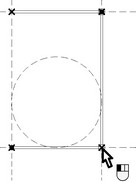
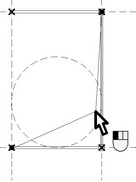
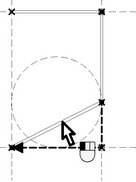
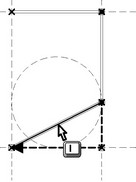
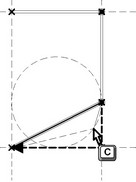
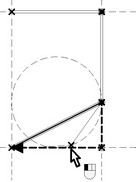

What is left is to press twice the ![]() icon or <End> key, and the contour editing task is complete. Then, adjust the graphic lines accordingly, if necessary.
icon or <End> key, and the contour editing task is complete. Then, adjust the graphic lines accordingly, if necessary.
Displaying the contour point numbers
To toggle the display of the contour point numbers of a 2D path, use the option:
![]() <Q> Show/Hide contour point numbers
<Q> Show/Hide contour point numbers
With the option turned on, the points in the path are enumerated based on their position in the path and the path direction. A point number is displayed next to the respective node. When several subsequent points of a contour coincide, their numbers are displayed next to each other, separated by commas.
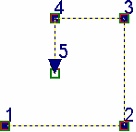
With the option turned on, the points in the path are enumerated based on their position in the path and the path direction. A point number is displayed next to the respective node. When several subsequent points of a contour coincide, their numbers are displayed next to each other, separated by commas.